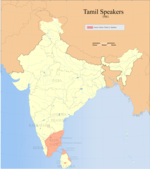
Back شتات تاميلي Arabic پراکنش تامیلیها Persian Diaspora tamoule French Diaspora Tamil ID Diaspora Tamil Malay புலம்பெயர் தமிழர் Tamil
This article needs additional citations for verification. (May 2019) |
புலம்பெயர் தமிழர் | |
|---|---|
| Total population | |
| 8 million | |
| ~1,897,000 (2018.est)[1] | |
| ~600,000 (2013)[2] | |
| ~400,000[3][4] | |
| ~350,000[4][3] | |
| ~302,000[5] | |
| ~238,699[6] | |
| 237,599 (2021)[7][b] | |
| 198,449 (2020)[c][8] | |
| ~120,000 (2007)[9] | |
| ~75,000 (2008)[10] | |
| ~72,089 (2011)[11] | |
| ~60,000 (2008)[12] | |
| ~50,000 (2011)[13] | |
| ~35,000 (2008)[14] | |
| ~25,000 (2005)[15] | |
| ~10,000 (2000)[16] | |
| ~9,000 (2003)[17] | |
| Languages | |
| |
| Religion | |
| |
| Part of a series on |
| Tamils |
|---|
 |
|
|
The Tamil diaspora refers to descendants of the Tamil speaking immigrants who emigrated from their native lands in the southern Indian subcontinent (Tamil Nadu, Puducherry and Sri Lanka) to other parts of the world. They are found primarily in Malaysia, Arab states of the Persian Gulf, South Africa, North America, Western Europe, and Singapore.[18] It can be divided into two main diasporic clusters, due to geographical, historical and cultural reasons, as Indian Tamil diaspora and Sri Lankan Tamil diaspora.
Four groups make up the bulk of the Tamil diaspora: colonial-era descendants of migrants to Southeast Asia, South Africa, East Africa, the Caribbean, and Fiji; recent, educated Tamil immigrants primarily to the U.S., Australia, and the U.K.; Sri Lankan Tamil refugees who resettled primarily in Canada, Western and Northern Europe, and Oceania between the 1980s and 2010s; and recent Tamil migration to the Gulf states of the Middle East as labor.
- ^ "Tamil Ethnologue". Ethnologue. 2010-03-26. Retrieved 2008-06-26.
Tamil Ethnologue.
- ^ "Navaneetham Pillay The most famous South African Tamil of our times". DailyMirror. 2013-08-31.
- ^ a b Rajan S.I., Rajan E.S. (2019) Tamil Nadu Migrants in the Gulf. In: Rajan S., Saxena P. (eds) India's Low-Skilled Migration to the Middle East. Palgrave Macmillan, Singapore. https://doi.org/10.1007/978-981-13-9224-5_11
- ^ a b Cite error: The named reference
IANS2016was invoked but never defined (see the help page). - ^ Murugaiyan, Appasamy (2013). "Le tamoul". In Kremnitz, Georg (ed.). Histoire sociale des langues de France (in French). Presses Universitaires de Rennes. pp. 881–889. ISBN 978-2-7535-2723-2.
- ^ Cite error: The named reference
uscensuswas invoked but never defined (see the help page). - ^ Government of Canada, Statistics Canada (2022-08-17). "Census Profile, 2021 Census of Population Profile table Canada [Country]". www12.statcan.gc.ca. Retrieved 2022-09-12.
- ^ Census of Population 2020 Statistical Release 1: Demographic Characteristics, Education, Language and Religion (PDF). Department of Statistics, Ministry of Trade & Industry, Republic of Singapore. June 2011. p. 51. ISBN 978-981-18-1381-8.
- ^ "Britain urged to protect Tamil Diaspora". BBC. 2006-03-26. Retrieved 2008-06-26.
According to HRW, there are about 120,000 Sri Lankan Tamils in the UK.
- ^ "Census TableBuilder - Log in". Auth.censusdata.abs.gov.au. Retrieved 17 August 2018.
- ^ "Volume: II Demographic and Fertility Characteristics" (PDF). The 2011 Housing and Population Census. Statistics Mauritius. p. 68.
- ^ Baumann, Martin (2008). "Immigrant Hinduism in Germany: Tamils from Sri Lanka and Their Temples". Harvard University. Retrieved 2008-06-26.
Since the escalation of the Sinhalese-Tamil conflict in Sri Lanka during the 1980s, about 60,000 came as asylum seekers.
- ^ "2011 Census of Population and Housing". Australian Bureau of Statistics. 18 May 2011.
- ^ "Swiss Tamils look to preserve their culture". Swissinfo. 2006-02-18. Retrieved 2008-06-25.
An estimated 35,000 Tamils now live in Switzerland.
- ^ "Tamil Diaspora - Italy - இத்தாலி". Tamilnation.co. Retrieved 17 August 2018.
- ^ Raman, B. (2000-07-20). "Sri Lanka: The dilemma". The Hindu. Archived from the original on 2009-01-24. Retrieved 2008-06-26.
It is estimated that there are about 10,000 Sri Lankan Tamils in Norway -- 6,000 of them Norwegian citizens, many of whom migrated to Norway in the 1960s and the 1970s to work on its fishing fleet; and 4,000 post-1983 political refugees.
- ^ Mortensen, V. Theology and the Religions: A Dialogue, p. 110
- ^ "March 1984". UNESCO. 2017-04-25. Retrieved 2021-01-06.
Cite error: There are <ref group=lower-alpha> tags or {{efn}} templates on this page, but the references will not show without a {{reflist|group=lower-alpha}} template or {{notelist}} template (see the help page).
© MMXXIII Rich X Search. We shall prevail. All rights reserved. Rich X Search